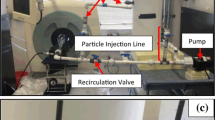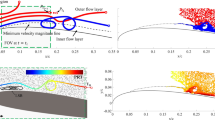Abstract
In this study, the liquid flow in a reverse-flow hydrocyclone is studied experimentally using the Lagrangian approach. Resin beads with densities that are close to the density of the liquid in which they move, i.e., neutral-density particles, are used to model a fluid element in the highly turbulent flow in a hydrocyclone separator and tracked using PEPT with a temporal resolution of up to 0.5 ms. A method of producing neutral-density particles for PEPT was developed. The data processing algorithm was improved for the extra challenging tracking conditions that were encountered. The components of velocity, which reveal the detailed velocity field of the fluid, were calculated from the positions of the tracers. Various noise-removal methods, again to cope with the challenging tracking conditions, were applied and discussed.





















Similar content being viewed by others
References
Alexander RM (1949) Fundamentals of cyclone design and operation. Proc Aust Inst Min Metall 152–153:203–228
Bailey DL (2005) Positron emission tomography: basic sciences. Springer, New York
Barker A, Bock J, Lorenz R, Markl M (2010) 4D flow MR imaging. MAGNETOM Flash 2:46–52
Barth W (1956) Berechnung und auslegung von zyklonabscheidern auf grund neuerer. Brennstoff-Wärme-Kraft 8(1):1–9
Bergström J, Vomhoff H (2005) Application of a pitometer to measure the tangential velocity in a cylindrical through-flow hydrocyclone operated with a fiber suspension. Nord Pulp Pap Res J 20(1):30–35
Bergström J, Vomhoff H (2007) Experimental hydrocyclone flow field studies. Sep Purif Technol 53(1):8–20. doi:10.1016/j.seppur.2006.09.019
Bergström J, Vomhoff H, Söderberg D (2007) Tangential velocity measurements in a conical hydrocyclone operated with a fibre suspension. Miner Eng 20(4):407–413. doi:10.1016/j.mineng.2006.09.008
Blaj O, Merzeau P, Snabre P, Pouligny B (2011) An automated single-particle tracker: application to characterization of non-azimuthal motion in Couette flows at low Reynolds number. Exp Fluids 50(6):1559–1570. doi:10.1007/s00348-010-1013-y
Chang YF, Ilea CG, Aasen ØL, Hoffmann AC (2011) Particle flow in a hydrocyclone investigated by positron emission particle tracking. Chem Eng Sci 66(18):4203–4211. doi:10.1016/j.ces.2011.06.001
Chang YF, Adamsen TC, Hoffmann AC (2012) Using a pet camera to track individual phases in process equipment with high temporal and spatial resolutions: Algorithm development. In: 2012 IEEE international instrumentation and measurement technology conference (I2MTC), pp 2326–2330
Chang YF, Adamsen TCH, Pisarev GI, Hoffmann AC (2013) PEPT: An invaluable tool for 3-D particle tracking and CFD simulation verification in hydrocyclone studies. EPJ Web Conf 50:05,001p.1–p.8. 10.1051/epjconf/20135005001
Cheng NS (2008) Formula for the viscosity of a glycerol–water mixture. Ind Eng Chem Res 47(9):3285–3288. doi:10.1021/ie071349z
Dabir B, Petty CA (1986) Measurements of mean velocity profiles in a hydrocyclone using laser Doppler anemometry. Chem Eng Commun 48(4–6):377–388. doi:10.1080/00986448608910025
Fan X, Parker D, Smith M (2006) Labelling a single particle for positron emission particle tracking using direct activation and ion-exchange techniques. Nucl Instrum Methods Phys Res Sect A Accel Spectrom Detect Assoc Equip 562(1):345–350
Fisher MJ, Flack RD (2002) Velocity distributions in a hydrocyclone separator. Exp Fluids 32(3):302–312. doi:10.1007/S003480100344
Frisch U, Hoekstra AJ, Vliet E, Derksen JJ, Akker HEA (1998) Vortex core precession in a gas cyclone. Adv Turbul VII Fluid Mech Appl 46:289–292
Hoffmann AC, Stein LE (2007) Gas cyclones and swirl tubes: principles, design and operation. Springer, New York
Hoffmann AC, Dechsiri C, van de Wiel F, Dehling H (2005) PET investigation of a fluidized particle: spatial and temporal resolution and short term motion. Meas Sci Technol 16(3):851–858
Hsieh KT, Rajamani K (1988) Phenomenological model of the hydrocyclone: model development and verification for single-phase flow. Int J Miner Process 22(1–4):223–237. doi:10.1016/0301-7516(88)90065-8
Hwang CC, Shen HQ, Zhu G, Khonsari MM (1993) On the main flow pattern in hydrocyclones. J Fluids Eng 115(1):21–25. doi:10.1115/1.2910106
Knowles SR, Woods DR, Feuerstein IA (1973) The velocity distribution within a hydrocyclone operating without an air core. Can J Chem Eng 51(3):263–271
Laverman JA, Fan X, Ingram A, Parker DJ, Seville JPK, Kuipers JAM (2012) Experimental study on the influence of bed material on the scaling of solids circulation patterns in 3d bubbling gas-solid fluidized beds of glass and polyethylene using positron emission particle tracking. Powder Technol 224:297–305
Lide D (2004) CRC handbook of chemistry and physics: a ready-reference book of chemical and physical data, 85th edn. CRC Press, Boca Raton
Lim EWC, Chen YR, Wang CH, Wu RM (2010) Experimental and computational studies of multiphase hydrodynamics in a hydrocyclone separator system. Chem Eng Sci 65(24):6415–6424
Monredon TC, Hsieh KT, Rajamani RK (1992) Fluid flow model of the hydrocyclone: an investigation of device dimensions. Int J Miner Process 35(1–2):65–83
Muschelknautz E (1980) Theorie der fliehkraftabscheider mit besonderer berücksichtigung hoher temperaturen und drücke. VDI-Berichte 363:49–60
Parker DJ, Leadbeater TW, Fan X, Hausard MN, Ingram A, Yang Z (2008) Positron imaging techniques for process engineering: recent developments at Birmingham. Meas Sci Technol 19(9):094004
Pisarev GI, Gjerde V, Balakin BV, Hoffmann AC, Dijkstra HA, Peng W (2012) Experimental and computational study of the “end of the vortex” phenomenon in reverse-flow centrifugal separators. AIChE J 58(5):1371–1380. doi:10.1002/aic.12695
Press WH, Flannery BP, Teukolsky SA, Vetterling WT (1992) Numerical recipes in C: the art of scientific computing. Cambridge University Press, Cambridge
Savitzky A, Golay M (1964) Smoothing and differentiation of data by simplified least squares procedures. Anal Chem 36(8):1627–1639
Seo KW, Choi YS, Lee SJ (2012) Dean-coupled inertial migration and transient focusing of particles in a curved microscale pipe flow. Exp Fluids 53(6):1867–1877. doi:10.1007/s00348-012-1403-4
van Campen L, Mudde RF, Slot J, Hoeijmakers H (2012) A numerical and experimental survey of a liquid–liquid axial cyclone. Int J Chem React Eng 10(1):A35
Acknowledgments
The Petromaks program by the Norwegian Research Council and Aker Solutions are gratefully acknowledged for funding this work.
Author information
Authors and Affiliations
Corresponding author
Rights and permissions
About this article
Cite this article
Chang, YF., Hoffmann, A.C. A Lagrangian study of liquid flow in a reverse-flow hydrocyclone using positron emission particle tracking. Exp Fluids 56, 4 (2015). https://doi.org/10.1007/s00348-014-1875-5
Received:
Revised:
Accepted:
Published:
DOI: https://doi.org/10.1007/s00348-014-1875-5




